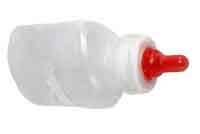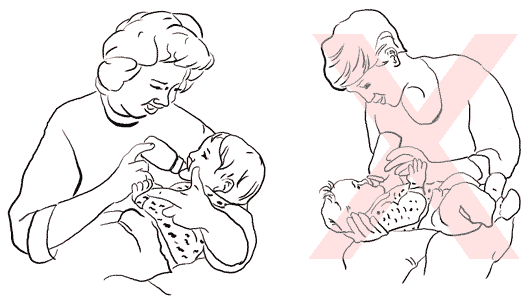Feeding an infant with cleft lip and palate
Babies with cleft lips and/or palates have their own unique ways of sucking from a bottle. They may require special bottles or nipples and some extra patience.
Infant feeding
Many babies with cleft lips or cleft palates eat just fine by mouth and need no extra nutrient supplementation. Some have a few feeding problems, and others have more difficulty and require more assistance. Talk with your baby’s doctor or a feeding specialist to decide what type of help your infant may need.
All newborns instinctively search for the nipple, suck, and swallow. Babies with cleft lips also seek out the nipple but may have problems latching on efficiently because of a poor lip seal around the nipple.
Cleft palates present a different challenge. Because of the opening between the mouth and the nasal cavity, it’s hard to create a good suction to draw liquid from the nipple. In addition, liquid can be lost through the nose. These babies tend to chew on the nipple rather than suck. And they may need special bottles and nipples to help them out.
Choosing a bottle or nipple
 Fig. 1 Haberman cleft palate feeder
Fig. 1 Haberman cleft palate feeder
When buying a baby bottle, the most important thing to look for is the softness of the plastic. Soft plastic bottles allow the feeder to squeeze slightly and help control the flow of liquid. Some commercially available bottles are soft.
There are several different nipples available for babies with cleft palate. An effective nipple usually is soft and has a cross cut or several extra holes. Preemie nipples or regular juice cross-cut nipples work for some infants but are too small for others.
 Fig. 2 Mead-Johnson cleft palate feeder
Fig. 2 Mead-Johnson cleft palate feeder
The Haberman Feeder is a feeding unit designed especially for babies with cleft palates (Fig. 1). This bottle has a specially designed nipple that keeps liquid in the nipple once the nipple has been sucked. The liquid does not flow back out, as in most nipples. It has a slice-cut hole that responds to the typical chewing action of these infants. You can present the nipple in one of three different directions, to make the liquid come out in slow, medium, or fast mode, depending on the needs of the infant.
The Mead Johnson Cleft Palate Nurser® set is another feeding unit that comes with a cross-cut soft nipple (Fig. 2). It has a slightly longer nipple than most. This places the liquid a bit farther back on the tongue. The softness and cross cut combination allows the chewing action to release liquids more easily than a regular nipple.
Positions
Experiment with your baby to find good positions for both of you. Each child and mother/father team is different. You may need to change your baby’s position and the nipple presentation to help your baby eat more efficiently.
Any position you choose should be as nearly upright as possible (Fig. 3). When the baby’s head is upright, gravity helps pull liquid into the throat and stomach rather than into the nose or middle ear space. Avoiding the back of the nose is important because babies with cleft palates are at a higher risk for ear infections. Constant improper flow of liquid increases the likelihood of liquid backing up and causing infection in the Eustachian tubes between the throat and ears.
 Fig. 3 Correct and incorrect feeding positions
Fig. 3 Correct and incorrect feeding positions
Presenting the bottle
Hold your baby’s cheeks forward to help create a smaller space in the mouth and increase the oral contact with the nipple.
If your baby has a cleft lip, try gently holding the upper lip together while bottle feeding, to help create the needed seal around the nipple. This may require some creative finger maneuvering on your part—experiment!
Burp your baby
Because more air is swallowed when the baby doesn’t have good suction, remember to burp your baby regularly. The extra air in the stomach takes up space that could be filled with food and increases the chances of spitting up after the meal.
Growth
Good nutrition is very important for all babies, and even more so for babies facing surgery. Your baby must make a good weight gain to be healthy enough for corrective surgery on the lips and/or palate. You should expect a minimum of ½ oz. of weight gain per day (approximately 4 oz. per week). Discuss any questions you have about your child’s weight gain with your baby’s doctor.
Adapted from Cleft Lip and Palate: Bottle Feeding and Your Baby, Therapy Skill Builders, a division of Communication Skill Builders, Inc. ©1994